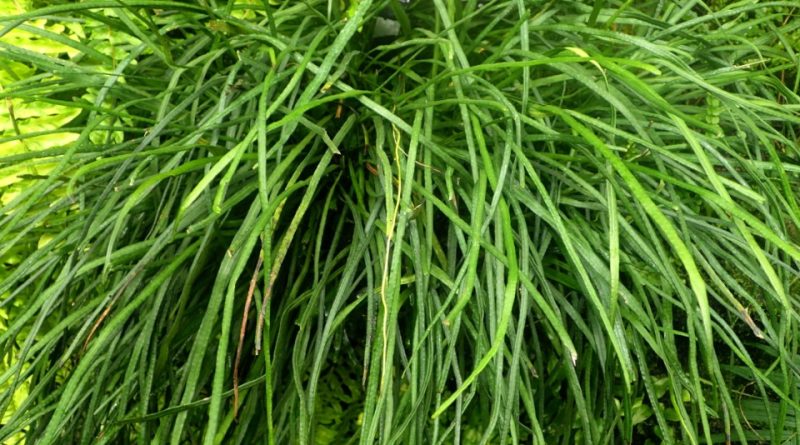Campyloneurum angustifolium
Campyloneurum angustifolium
The Narrow-Leaf Strap Fern (Campyloneurum angustifolium (Sw.) Fée 1852) is a fern belonging to the Polypodiaceae family.
Systematics –
From a systematic point of view it belongs to:
Eukaryota Domain,
Kingdom Plantae,
Subarign Tracheobionta,
Pteridophyta division,
Polypodiopsida class,
Order Polypodiales,
Polypodiaceae family,
Genus Campyloneurum,
C. angustifolium species.
The following terms are synonymous:
– Campyloneurum difforme T. Moore;
– Campyloneurum ensifolium (Willd.) J. Sm .;
– Campyloneurum taeniosum (Willd.) Fée;
– Cyrtophlebium angustifolium (Sw.) J. Sm .;
– Cyrtophlebium difforme Lodd .;
– Goniophlebium angustifolium (Sw.) Brack .;
– Grammitis angustifolia (Sw.) Heward;
– Marginaria angustifolia (Sw.) C. Presl;
– Marginaria ensifolia (Willd.) C. Presl;
– Polypodium angustifolium Sw .;
– Polypodium calaguala Ruiz;
– Polypodium difforme (Lodd.) Kunze;
– Polypodium ensifolium Willd .;
– Polypodium taeniosum Willd ..
Etymology –
The term Campyloneurum comes from the Greek kampylos, curved, and neuron, nerve, referring to the grain.
The specific epithet angustifolium comes from narrow, narrow angustus and from folium leaf, lamella: with narrow or small leaves (or leaflets).
Geographic Distribution and Habitat –
Campyloneurum angustifolium is a fern native to an area that includes: Florida, Puerto Rico, Cuba, Jamaica, Mexico, Mesoamerica, Central America, Kerala and tropical South America.
Its habitat is that on tree trunks or in the ravines of rocks, in open or shady places, forests from 100 to 2,500 meters above sea level. and occasionally up to 3,600 meters.
Description –
Campyloneurum angustifolium is a fern characterized by short and creeping stems with a diameter of 3-7 mm which is formed by a short and creeping rhizome.
The leaves are generally numerous, from arched to hanging with an essentially absent petiole at about 3-5 (8) cm; the leaf blade is yellowish to dark green, elongated-linear, ± falcata, 30-70 × 0.5-1.5 cm, of paper consistency; base and long apex attenuated; margins often slightly revolute. Presence of dark veins, inconspicuous primary veins, slightly to strongly curved, areoles in 1–4 series between rib and margin, with free included veins.
Sori present in 1-2 rows on each side of the coast.
Cultivation –
Campyloneurum angustifolium is an epiphytic fern that grows on oaks, magnolias and other rough-barked trees in swamps on subacid substrate.
This plant propagates via spores and is used for medicinal purposes by the Chinchero tribes in southern Peru, where it is sometimes transplanted into home gardens.
Customs and Traditions –
Campyloneurum angustifolium is a fern file that has long been used in medicine by the Chinchero tribes in southern Peru.
While we have not found any reports of toxicity for this species, several ferns contain carcinogens, so some caution is advised.
Many ferns also contain thiaminase, an enzyme that deprives the body of its B vitamin complex. In small amounts, this enzyme does not harm people on an adequate diet rich in B vitamins; in larger quantities you can have serious health problems. The enzyme is destroyed by heat or complete drying, whereby cooking the plant removes thiaminase.
The plant is diaphoretic and pectoral and is used in the treatment of fever and dropsy.
Preparation Method –
The rhizomes and roots of this plant for medicinal use are used and it is taken through decoctions that are drunk before meals as a remedy for throat infections and asthma.
Guido Bissanti
Sources
– Acta Plantarum – Flora of the Italian Regions.
– Wikipedia, the free encyclopedia.
– Useful Tropical Plants Database.
– Conti F., Abbate G., Alessandrini A., Blasi C. (ed.), 2005. An annotated checklist of the Italian vascular flora, Palombi Editore.
– Pignatti S., 1982. Flora of Italy, Edagricole, Bologna.
– Treben M., 2000. Health from the Lord’s Pharmacy, Advice and experiences with medicinal herbs, Ennsthaler Editore.
Photo source: http://www.plantillustrations.org/illustration.php?id_illustration=282214&uhd=2&mobile=0
Warning: Pharmaceutical applications and alimurgical uses are indicated for informational purposes only, they do not represent in any way a medical prescription; therefore no responsibility is taken for their use for curative, aesthetic or food purposes.


